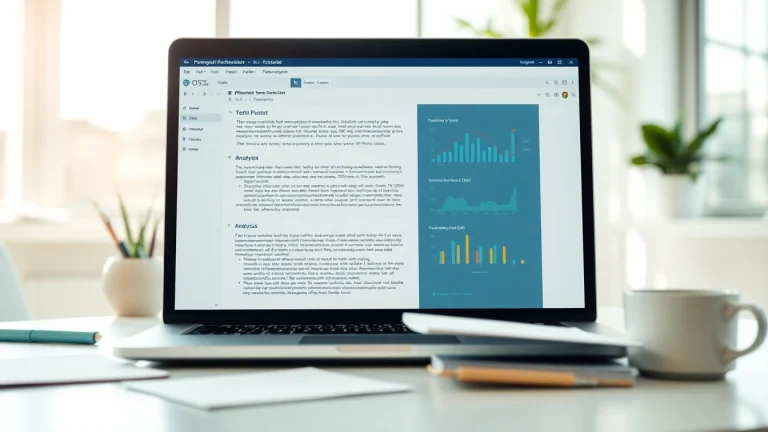
Essential Tips for Choosing the Right Plagiarism Checker
Understanding Plagiarism Checkers
What is a plagiarism checker?
A plagiarism checker is a specialized tool designed to identify instances of plagiarism in written content. These tools compare the submitted text against an extensive database of published works, articles, and other content available on the internet. By doing so, they can flag any sections of text that match existing sources, helping writers and researchers to ensure that their work is original and properly cited. Utilizing a plagiarism checker is crucial not only for academic integrity but also for maintaining a professional standard in any published content.
How does a plagiarism checker work?
Plagiarism checkers operate using algorithms that analyze text against proprietary databases and web sources. When a document is submitted, the checker breaks the text into smaller segments, often called n-grams. It then searches for these segments within its database to find matches. The process typically involves several key steps:
- Text Submission: Users upload a document or paste the text they wish to check.
- Text Analysis: The tool scans the text for similarities by breaking it down into smaller parts.
- Database Comparison: The segments are compared against a vast repository of academic papers, articles, and online content.
- Report Generation: After the analysis, users receive a report detailing any instances of plagiarism, including links to original sources.
The effectiveness of a plagiarism checker is often determined by the size of its database and the sophistication of its algorithms.
Types of plagiarism checkers available
There are various types of plagiarism checkers available in the market, catering to different needs and users. These include:
- Free Online Checkers: Accessible tools available at no cost, suitable for casual users or students checking basic documents.
- Paid Services: More comprehensive tools that offer advanced features like deeper internet searches, integrations with citation managers, and more detailed reports.
- Institutional Tools: Often used by schools and universities, these checkers integrate with educational platforms, providing more robust evaluations and reports.
- Specialized Academic Checkers: Designed for researchers and academics, focusing on scholarly content and providing specific insights into citation and originality.
Benefits of Using a Plagiarism Checker
Protecting originality in academic work
One of the primary benefits of using a plagiarism checker is ensuring the originality of academic work. Students, researchers, and professionals must produce unique content to contribute meaningfully to their fields. By identifying potential instances of unintentional plagiarism, these tools help maintain academic integrity and credibility.
Avoiding unintentional plagiarism
Unintentional plagiarism can occur when authors inadvertently use phrases, ideas, or layouts from other sources without proper attribution. Plagiarism checkers can catch these inadvertent mistakes, providing the opportunity to correct them before submission. This preventive measure is especially beneficial for students who may not yet fully understand citation norms.
Improving writing skills through feedback
In addition to identifying plagiarism, many checkers provide grammatical feedback, suggesting improvements to writing style, structure, and clarity. By using these tools, writers can enhance their skills, allowing them to produce higher-quality content. Over time, regular use of these checkers can lead to noticeable improvements in writing proficiency.
Key Features to Look for in a Plagiarism Checker
Accuracy and reliability of results
The foremost factor in choosing a plagiarism checker is its accuracy. An effective tool should provide reliable results that reflect the true originality of submitted texts. Checkers with extensive databases and those regularly updated will yield the most accurate comparisons. Users often benefit from reading reviews and user testimonials to gauge a checker’s reliability.
User-friendly interface and functionality
Since convenience is key, a user-friendly interface is essential for a plagiarism checker. A straightforward design that allows users to upload documents easily and interpret results quickly will enhance the user experience. Features like instant reporting and easy navigation through similar content greatly support users in understanding the results.
Support for multiple file formats and languages
Diverse file format support is another critical feature. A good plagiarism checker should accept various file types, including .docx, .pdf, and .txt to accommodate different users’ needs. Additionally, support for multiple languages enables broader usage and promotes inclusivity among non-English speaking users.
Top Mistakes to Avoid When Using a Plagiarism Checker
Relying solely on automated checks
While plagiarism checkers serve as valuable tools, it is essential not to rely solely on automated results. These tools cannot fully understand context or assess nuanced arguments. Writers should still engage in manual checks and review their work critically after receiving a report from the plagiarism checker.
Ignoring citation guidelines
Some users may overlook proper citation practices, assuming that a plagiarism checker will catch all errors. However, users are responsible for following specific citation styles and ensuring that paraphrased content is appropriately credited. Familiarity with citation guidelines significantly reduces the risk of plagiarism.
Failing to review the reports comprehensively
Many users may hastily glance through the results of a plagiarism check without fully understanding them. It’s crucial to take the time to analyze the report carefully, distinguishing between flagged references that require attention and those that do not. Engaging with the feedback comprehensively will enhance the overall quality of the work.
Best Practices for Effective Plagiarism Checking
Using plagiarism checkers regularly
To maintain the integrity of all written work, individuals should incorporate plagiarism checks into their writing process regularly. This practice fosters a better understanding of what constitutes original writing and reinforces the importance of citations. Frequent use can help make plagiarism checking a habit, ensuring that all content is properly vetted before submission.
Integrating feedback into your writing process
Feedback from a plagiarism checker should not be ignored. Writers should actively incorporate the feedback received from these tools into their revision process. This integration encourages continuous improvement and helps refine writing skills over time.
Staying updated on plagiarism trends
As academic integrity policies evolve alongside writing practices, writers must stay informed about current trends in plagiarism and copyright laws. By remaining updated on these changes, individuals can ensure they are implementing best practices and avoiding potential pitfalls in their writing.
In conclusion, utilizing a plagiarism checker is essential for anyone involved in academic or professional writing. By understanding how these tools function and the significant benefits they provide, individuals can protect their originality and enhance their writing effectiveness. By being aware of mistakes to avoid and following best practices, writers can navigate the complex world of academic integrity and maintain a reputable presence in their respective fields.


